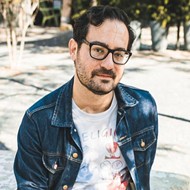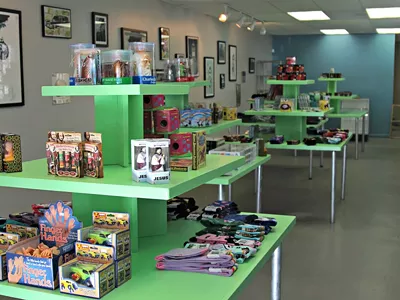Artist Scott Hocking is perhaps better known for his sculptural work, which has seen him utilize Detroit's abandoned spaces to create installations out of found materials. But from there, Hocking developed an additional body of work as a photographer by necessity in order to document his installations, which were often temporary. With his new book Detroit Nights, Hocking has created a series that is separate from his documentation photography, yet shares similar fleeting quality as his installation work. The book was published by Detroit-based design store Nora and is available to purchase from the store's Midtown location or the store's website. We spoke with Hocking by phone to learn more.
Metro Times: How did this book project come about?
Scott Hocking: I've been taking photos for a long time. I have a lot of different concurrent series that I work on — one of them is photographs at night. Sometimes it's because I'm doing other projects where I'm out at night, and other times it's specifically because I want to photograph something at night, or maybe there's a really great atmospheric condition. Or maybe I'm up late, I can't sleep. So I've been doing it since the '90s, but like a lot of projects, I didn't think of it as a series until a lot later. I have a lot of photos from the late '90s to the early 2000s that are night photos of Detroit. I started to think of things as a series later, maybe in the mid-2000s. There's a number of photos from 2007 and 2008 that are in there, but the majority of them are from the last five years.
MT: There's a great sense of curation — everything is at once serene, yet eerie.
Hocking: A lot of my work and a lot of what I'm interested in is connected to my own interest in working in solitude. The meditation that goes into it, the solace — I try to find places in the city that are good for me personally, and I think I need those kinds of places and those kinds of times. I also think that in some cases it's a thing that people don't think of when they think of Detroit at night. Even myself as a kid, I wouldn't have necessarily been as comfortable as I am now just hanging out, doing these long exposures in the middle of the night. In a lot of cases, if there's one photo in the book of me at some place in the city that is very desolate or quiet, it means I was there for at least an hour, trying to get a shot. On any given night I might be out for two or three hours. I think that kind of comes through in the photos. It's usually just me and the damn camera out there. I'm not out with a gang of guys. It's just me.
MT: While creating the photos for this book, did you have any scary stories?
Hocking: I'm really familiar with the city. I've lived here my whole life. There definitely have been times over the course of my life and in the course of this career of being an artist that I've encountered situations that are scary for different reasons. It just takes time. I'm at a point now where I can still be in a circumstance where I'm cautious. It's Detroit. You still always have to be very vigilant of where you are and what you're doing. You instantly put yourself in a kind of dumb scenario when you go out in the middle of the night to the middle of nowhere with this expensive camera equipment. That's not even Detroit-centric — that's just something that if you did, it would be somewhat risky. But I think there's a certain element of overcoming that stuff to do what you want to do. Even to this day I'll still have moments of thinking, "Oh boy." But that's kind of my M.O. I put myself in dumb circumstances where I get a little bit scared, but it passes. Really the most dangerous things that have ever happened to me in my life aren't due to people. It's either me being chased by dogs, or doing something like falling in a hole. I've always been able to somehow navigate around people.
MT: Do you use a tripod to take these long exposures?
Hocking: I have to, but I don't always have a tripod. That's kind of another remnant of me being a stubborn person who wants to go out and explore, but doesn't want to have a bunch of baggage. For a long time — especially the earlier photos — I don't have a tripod with me, so I just find things to use as a tripod. That could be a windowsill, or any part of a concrete structure nearby, or fire hydrants — just whatever I can find. A lot of photos that I've taken, they have the vantage point that they have because there was something there that I could set the camera up.
MT: Are you currently working on any other projects?
Hocking: The way I usually work, I kind of have to keep things secret. I like it to be something that can be discovered — but I also know that if I start talking about it and it gets discovered before I'm done there's a good chance it will get destroyed before I'm done. So there's a couple things that are longstanding projects that I'm still tinkering with. What I've been most busy with this year have been three projects that have not been secret. I just finished a huge installation in northern France about an hour north of Paris, in Lille. I finished that, and wrapped up a project in Michigan's thumb, in Port Austin, where I was commissioned to take down a barn and rebuild it as a sculpture. Then before that was a project on the east side of Detroit for a project called Detroit Boom City in the old Pickle Factory.
MT: Are those your primary bodies of work — sculpture and phography?
Hocking: Most of what I do now ends up being characterized as a site-specific installation and photography project. In most cases it doubles as both. The photos might be seen in an exhibition space in a gallery, and they're usually seen by a very different audience than the people who encounter things onsite. That's something that's taken me a long time to get confident in, because I'm not a trained photographer. I think of myself as a sculptor still.
Detroit Nights is available from Nora; 4240 Cass Ave., Ste. 109, Detroit; 313-831-4845; noramodern.com; $30.







